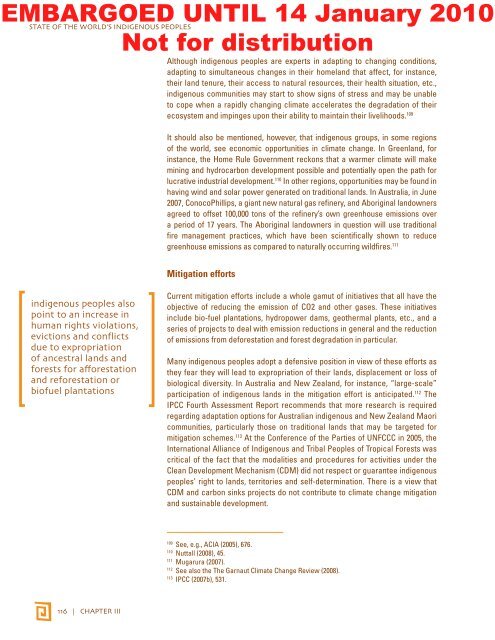STATE OF THE WORLD's INDIGENOUs PEOpLEs - CINU
STATE OF THE WORLD's INDIGENOUs PEOpLEs - CINU
STATE OF THE WORLD's INDIGENOUs PEOpLEs - CINU
- No tags were found...
You also want an ePaper? Increase the reach of your titles
YUMPU automatically turns print PDFs into web optimized ePapers that Google loves.
EMBARGOED UNTIL 14 January 2010<strong>STATE</strong> <strong>OF</strong> <strong>THE</strong> WORLD’S INDIGENOUS PEOPLESNot for distributionAlthough indigenous peoples are experts in adapting to changing conditions,adapting to simultaneous changes in their homeland that affect, for instance,their land tenure, their access to natural resources, their health situation, etc.,indigenous communities may start to show signs of stress and may be unableto cope when a rapidly changing climate accelerates the degradation of theirecosystem and impinges upon their ability to maintain their livelihoods. 109It should also be mentioned, however, that indigenous groups, in some regionsof the world, see economic opportunities in climate change. In Greenland, forinstance, the Home Rule Government reckons that a warmer climate will makemining and hydrocarbon development possible and potentially open the path forlucrative industrial development. 110 In other regions, opportunities may be found inhaving wind and solar power generated on traditional lands. In Australia, in June2007, ConocoPhillips, a giant new natural gas refinery, and Aboriginal landownersagreed to offset 100,000 tons of the refinery’s own greenhouse emissions overa period of 17 years. The Aboriginal landowners in question will use traditionalfire management practices, which have been scientifically shown to reducegreenhouse emissions as compared to naturally occurring wildfires. 111Mitigation effortsindigenous peoples alsopoint to an increase inhuman rights violations,evictions and conflictsdue to expropriationof ancestral lands andforests for afforestationand reforestation orbiofuel plantationsCurrent mitigation efforts include a whole gamut of initiatives that all have theobjective of reducing the emission of CO2 and other gases. These initiativesinclude bio-fuel plantations, hydropower dams, geothermal plants, etc., and aseries of projects to deal with emission reductions in general and the reductionof emissions from deforestation and forest degradation in particular.Many indigenous peoples adopt a defensive position in view of these efforts asthey fear they will lead to expropriation of their lands, displacement or loss ofbiological diversity. In Australia and New Zealand, for instance, “large-scale”participation of indigenous lands in the mitigation effort is anticipated. 112 TheIPCC Fourth Assessment Report recommends that more research is requiredregarding adaptation options for Australian indigenous and New Zealand Maoricommunities, particularly those on traditional lands that may be targeted formitigation schemes. 113 At the Conference of the Parties of UNFCCC in 2005, theInternational Alliance of Indigenous and Tribal Peoples of Tropical Forests wascritical of the fact that the modalities and procedures for activities under theClean Development Mechanism (CDM) did not respect or guarantee indigenouspeoples’ right to lands, territories and self-determination. There is a view thatCDM and carbon sinks projects do not contribute to climate change mitigationand sustainable development.109See, e.g., ACIA (2005), 676.110Nuttall (2008), 45.111Mugarura (2007).112See also the The Garnaut Climate Change Review (2008).113IPCC (2007b), 531.116 | CHAPTER III
















